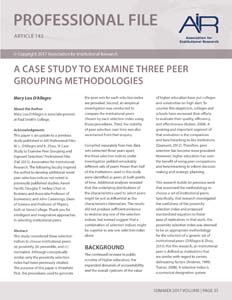AIR Professional File
Summer 2017, Article 142
A Case Study to Examine Three Peer Grouping Methodologies
http://doi.org/10.34315/apf1422017Abstract
This study considered three selection indices to choose institutional peers: (a) proximity, (b) percentile, and (c) normative. Although conceptually similar, only the proximity selection index had been previously studied. The purpose of this paper is threefold. First, the procedures used to generate the peer sets for each selection index are provided. Second, an empirical investigation was conducted to compare the institutional peers chosen by each selection index using those procedures. Third, the stability of peer selection over time was also ascertained from that enquiry.
Compiled separately from two data sets extracted three years apart, the three selection indices under investigation yielded remarkably different sets of peers. Fewer than half of the institutions used in this study were identified as peers at both points of time. Additional analyses revealed that the underlying distributions of the characteristics used to select peers might be just as influential as the characteristics themselves. The results did not produce sufficient evidence to endorse any one of the selection indices, but instead suggest that a combination of selection indices might be superior to any one selection index alone.
Authors
Mary Lou D’Allegro, Paul Smith’s Colleg
Acknowledgements
This paper is an update to a previous study published in AIR Professional Files: M. L. D’Allegro and K. Zhou, “A Case Study to Examine Peer Grouping and Aspirant Selection,” Professional Files (Fall 2013), Association for Institutional Research.
Copyright © Association for Institutional Research 2017

